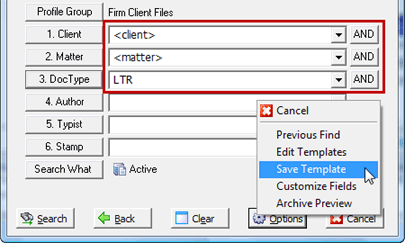• Overview
• Using profile field variables
• Accessing views, other searches that run immediately on selection
All searching in Worldox starts with a basic search form, the Find Files dialog. Search forms at your firm will probably be similar to the linked example.
Most often, searching in Worldox means filling out one of these search forms (also called "templates"):
• Select the search form to use.
• When the form opens, enter or select information (criteria) by which to search.
• With search criteria defined to your satisfaction, start the search.
Views start off as search forms, but differ from other forms in three ways:
First, views make use of special variable instructions - field names enclosed in brackets - in numbered profile fields.
Views are typically set to run immediately, rather than first showing the search form. You don't see the form; you don't define any search items. It just runs; you then see a list of results of the message that nothing was found.
Views also list automatically in the configurable My Workspaces zone. Regular search forms do not appear there..
Views start off as forms. The difference is in how the form is set up, also in how view listings display in the Search Templates dialog and in the My Workspaces zone.
Whereas most searching depends on specific criteria ("look for client=0031, document type=LTR or MEMO") view searching uses variables. As in this example:

Here the user is instructing Worldox to use any or all available Client and Matter values to search – whatever values are represented in those named fields, in whatever profile groups share those same field (in the same positions in the profile field hierarchy).
• Variables on search forms are profile field names surrounded by brackets.
Example: <Matter> is an instruction to find files whatever their Matter codes might be - assuming all other search criteria are also met.
• In the example above, two such variable instructions are combined with a specific document type, LTR.
• Using this view to search would produce a list of all letters in the Firm Client Files profile group - for any client, for any client matter. To make such a view even more useful, add a date range to the search before saving - last seven days in the Date Modified field perhaps. That way, the view would serve as an instant update on letters changed recently within specified profile group or groups.
You can tell which forms are views - set to run immediately upon selection on the Search pull-down menu and Search Template dialog list - by the small symbols to the left of form listings:
![]()
![]() denotes a view, or form set to run immediately
on selection. The same icon without that little green arrow indicates
the listing is a search form - meaning you see the form after selecting
this search, before the search begins.
denotes a view, or form set to run immediately
on selection. The same icon without that little green arrow indicates
the listing is a search form - meaning you see the form after selecting
this search, before the search begins.
To open a view for editing:
Both regular search forms and views can be changed or deleted, assuming you have the user rights to do so. Because you don't ordinarily see the view form after selecting it, there is a special way to access views to make changes.
You are looking for listings with the binoculars
![]() icon alongside - no little green arrow
underneath the icon. It does not matter at this point which form you choose.
icon alongside - no little green arrow
underneath the icon. It does not matter at this point which form you choose.
Click the found listing to open the form, in the Find Files dialog.
In the Find Files dialog, click Options and select Edit Template from the options menu. That opens the Edit Template dialog.
In the Edit
> Template dialog, find the view you want to edit. (Look
for the binoculars ![]() icon;
that symbol denotes a view.)
icon;
that symbol denotes a view.)
Select the view and click Select. That opens the search form used for this view so you can make changes.